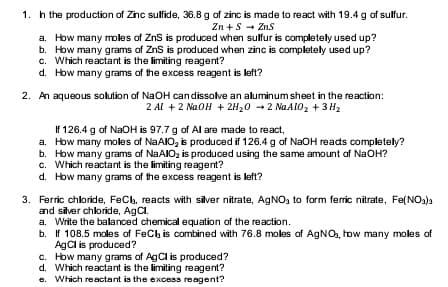1. h the production of Zhc sulfide, 36.8 g of zinc is made to react with 19.4 g of sulfur. Zn + S - Zns a. How many moles of ZnS is produced when sulfur is completely used up? b. How many grams of ZnS is produced when zinc is completely used up? c. Which reactant is the limiting reagent? d. How many grams of the excess reagent is left? 2. An aqueous solution of NaOH candissolve an aluminum sheet in the reaction: 2 Al +2 NaOH + 2H20 - 2 NaAlO, + 3 H2 If 126.4 g of NaOH is 97.7 g of Al are made to react, a. How many moles of NAAIO, s produced if 126.4 g of NaOH reads oompletely? b. How many grams of NAAIO, is produced using the same amount of NaOH? c. Which reactant is the limiting reagent? d. How many grams of the excess reagent is left? 3. Ferric chloride, FeCb, reacts with silver nitrate, AGNO, to form ferric nitrate, Fe(NOa)a and silver chloride, AgCl. a. Write the balanced chemical equation of the reaction. b. If 108.5 moles of FeCh is combined with 76.8 moles of AGNO, how many moles of AgCl is produced? c. How many grams of AgCl is produced? d. Which reactant is the limiting reagent? e. Which reactant is the excess reagent?
1. h the production of Zhc sulfide, 36.8 g of zinc is made to react with 19.4 g of sulfur. Zn + S - Zns a. How many moles of ZnS is produced when sulfur is completely used up? b. How many grams of ZnS is produced when zinc is completely used up? c. Which reactant is the limiting reagent? d. How many grams of the excess reagent is left? 2. An aqueous solution of NaOH candissolve an aluminum sheet in the reaction: 2 Al +2 NaOH + 2H20 - 2 NaAlO, + 3 H2 If 126.4 g of NaOH is 97.7 g of Al are made to react, a. How many moles of NAAIO, s produced if 126.4 g of NaOH reads oompletely? b. How many grams of NAAIO, is produced using the same amount of NaOH? c. Which reactant is the limiting reagent? d. How many grams of the excess reagent is left? 3. Ferric chloride, FeCb, reacts with silver nitrate, AGNO, to form ferric nitrate, Fe(NOa)a and silver chloride, AgCl. a. Write the balanced chemical equation of the reaction. b. If 108.5 moles of FeCh is combined with 76.8 moles of AGNO, how many moles of AgCl is produced? c. How many grams of AgCl is produced? d. Which reactant is the limiting reagent? e. Which reactant is the excess reagent?
Chemistry: Principles and Reactions
8th Edition
ISBN:9781305079373
Author:William L. Masterton, Cecile N. Hurley
Publisher:William L. Masterton, Cecile N. Hurley
Chapter3: Mass Relations In Chemistry; Stoichiometry
Section: Chapter Questions
Problem 70QAP: The first step in the manufacture of nitric acid by the Ostwald process is the reaction of ammonia...
Related questions
Question
Questions on the pictures

Transcribed Image Text:1. h the production of Zinc sulfide, 36.8 g of zinc is made to react with 19.4 g of sulfur.
Zn + S + Zns
a. How many moles of ZnS is produced when sulfur is completely used up?
b. How many grams of ZnS is produced when zinc is completely used up?
c. Which reactant is the limiting reagent?
d. How many grams of the excess reagent is left?
2. An aqueous solution of NaOH candissolve an aluminum sheet in the reaction:
2 Al + 2 NaOH + 2H20 -2 NAA1O2 + 3 H2
If 126.4 g of NaOH is 97.7 g of Al are made to react,
a. How many moles of NaAIO, is produced if 126.4 g of NaOH reads completely?
b. How many grams of NAAIO, is produced using the same amount of NaOH?
c. Which reactant is the limiting reagent?
d. How many grams of the excess reagent is left?
3. Ferric chloride, FeCb, reacts with silver nitrate, AGNO, to form ferric nitrate, Fe(NO3)a
and silver chloride, AgCl.
a. Write the balanced chemical equation of the reaction.
b. If 108.5 moles of FeCh is combined with 76.8 moles of AGNO, how many moles of
AgCl is produced?
c. How many grams of AgCl is produced?
d. Which reactant is the limiting reagent?
e. Which reactant is the excess reagent?
Expert Solution
This question has been solved!
Explore an expertly crafted, step-by-step solution for a thorough understanding of key concepts.
Step by step
Solved in 3 steps with 4 images

Knowledge Booster
Learn more about
Need a deep-dive on the concept behind this application? Look no further. Learn more about this topic, chemistry and related others by exploring similar questions and additional content below.Recommended textbooks for you

Chemistry: Principles and Reactions
Chemistry
ISBN:
9781305079373
Author:
William L. Masterton, Cecile N. Hurley
Publisher:
Cengage Learning

Introductory Chemistry: A Foundation
Chemistry
ISBN:
9781337399425
Author:
Steven S. Zumdahl, Donald J. DeCoste
Publisher:
Cengage Learning

Living By Chemistry: First Edition Textbook
Chemistry
ISBN:
9781559539418
Author:
Angelica Stacy
Publisher:
MAC HIGHER

Chemistry: Principles and Reactions
Chemistry
ISBN:
9781305079373
Author:
William L. Masterton, Cecile N. Hurley
Publisher:
Cengage Learning

Introductory Chemistry: A Foundation
Chemistry
ISBN:
9781337399425
Author:
Steven S. Zumdahl, Donald J. DeCoste
Publisher:
Cengage Learning

Living By Chemistry: First Edition Textbook
Chemistry
ISBN:
9781559539418
Author:
Angelica Stacy
Publisher:
MAC HIGHER

General Chemistry - Standalone book (MindTap Cour…
Chemistry
ISBN:
9781305580343
Author:
Steven D. Gammon, Ebbing, Darrell Ebbing, Steven D., Darrell; Gammon, Darrell Ebbing; Steven D. Gammon, Darrell D.; Gammon, Ebbing; Steven D. Gammon; Darrell
Publisher:
Cengage Learning

Chemistry: Matter and Change
Chemistry
ISBN:
9780078746376
Author:
Dinah Zike, Laurel Dingrando, Nicholas Hainen, Cheryl Wistrom
Publisher:
Glencoe/McGraw-Hill School Pub Co
